Learnings from Developing a Context-Specific LCA Tool for Buildings—The Case of LCAbyg 4
Abstract
1. Introduction
2. Materials and Methods
- Global warming potential total;
- Depletion potential of the stratospheric ozone layer;
- Acidification potential;
- Eutrophication potential freshwater;
- Formation potential of tropospheric ozone;
- Abiotic depletion potential for non-fossil resources;
- Abiotic depletion potential for fossil resources;
- Use of renewable primary energy excluding renewable primary energy resources used as raw materials;
- Use of non-renewable primary energy excluding non-renewable primary energy resources used as raw materials;
- Use of non-renewable secondary fuels.
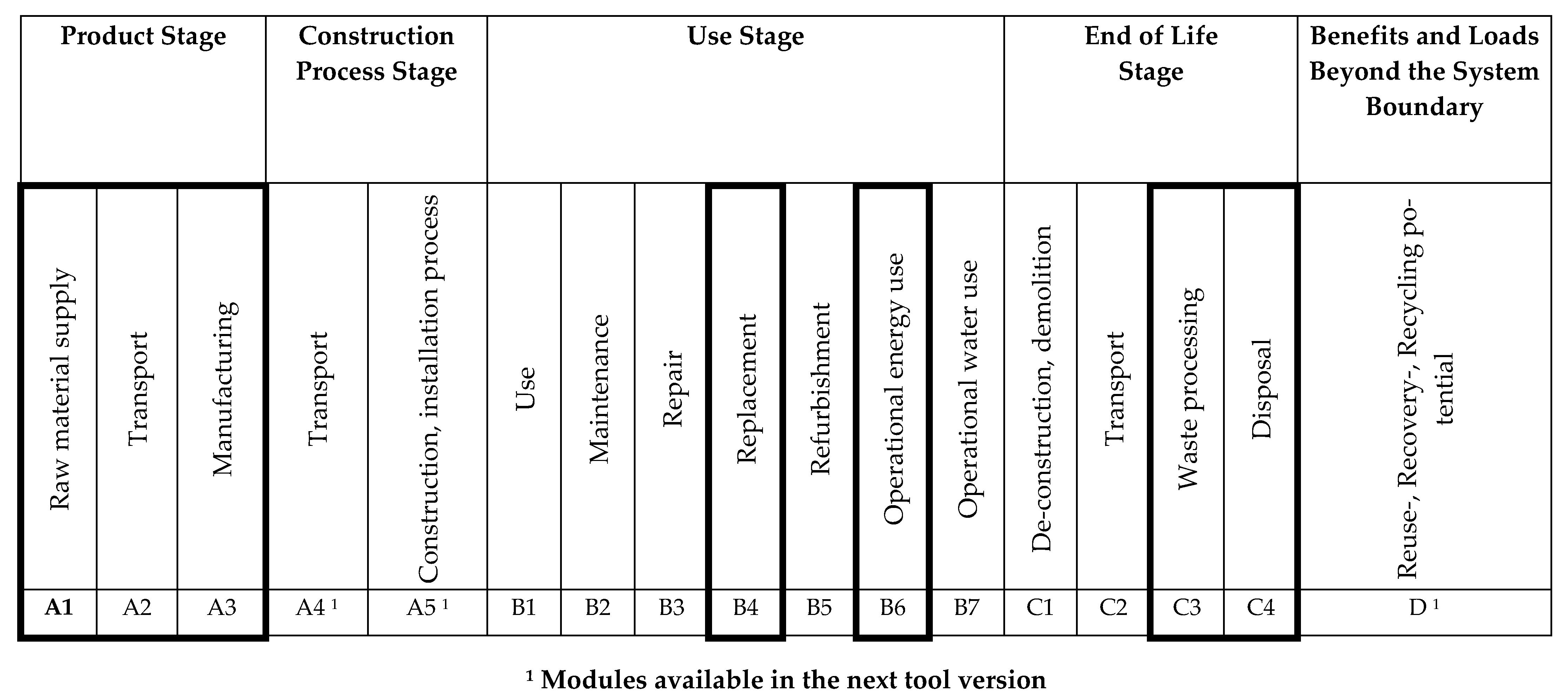
3. Results and Discussion
3.1. Stakeholder Requirements for Tool
- Available default data and settings;
- Versatility;
- Environmental feedback for informing design;
- Transparent results.
3.2. Tool Overview
3.3. Tool Features—Available Default Data and Settings
3.3.1. Building Model Structure
3.3.2. Component Library
3.3.3. Quantity Estimation Guide
3.4. Tool Feature—Versatility
3.4.1. User Profile and Level of Assessment
3.4.2. Model Data Exchange
3.5. Tool Feature—Environmental Feedback for Informing Design
Analysis
3.6. Tool Feature—Transparent Results
Quantities and Results
4. Conclusions
Future Development
Author Contributions
Funding
Institutional Review Board Statement
Informed Consent Statement
Data Availability Statement
Acknowledgments
Conflicts of Interest
Appendix A
| Topic: Your company | |||||
| Q1.1 How many employees does your company have? (1 answer) | |||||
| |||||
| |||||
| |||||
| |||||
| |||||
| Q1.2 What type of company is it? (1 answer) | |||||
| |||||
| |||||
| |||||
| |||||
| Obligatory text | ||||
| Q1.3 Does the company have employees, who work with sustainability across projects? (1 answer) | |||||
|  | Q1.3.1What tasks belong to your position (multiple answers) | |||
|
| ||||
|
| ||||
| |||||
| |||||
| |||||
| |||||
| Obligatory text | ||||
| |||||
| |||||
| |||||
| Q1.4 Is LCA part of the company’s services today? (1 answer) | |||||
| |||||
| |||||
| |||||
| |||||
| |||||
| Q1.5Has your company experienced barriers in offering LCA services? (1 answer) | |||||
| Obligatory text | ||||
| |||||
| |||||
| Q1.6Has you company experienced demand for LCA-based services? (1 answer) | |||||
| Obligatory text | ||||
| Obligatory text | ||||
| |||||
| Topic: Your professional background | |||||
| Q1.7What is your education? (multiple answers) | |||||
| |||||
| |||||
| |||||
| |||||
| |||||
| Obligatory text | ||||
| Q1.8What is your experiences as a building professional? (1 answer) | |||||
| |||||
| |||||
| |||||
| |||||
| |||||
| Q1.9What project stages have you primarily worked with during the last 5 years? (multiple answers) | |||||
| |||||
| |||||
| |||||
| |||||
| |||||
| |||||
| |||||
| |||||
| Obligatory text | ||||
| Q1.10In what technical field do you have special expertise? (multiple answers) | |||||
| |||||
| |||||
| |||||
| |||||
| |||||
| |||||
| |||||
| |||||
| |||||
| |||||
| |||||
| |||||
| |||||
| Obligatory text | ||||
| Q1.11Estimate your competence in the field of environmental assessment/LCA (1 choice) | |||||
| Low | Average | High | |||
| Q1.12How many whole building LCA have you conducted? (1 answer) | |||||
| |||||
| |||||
| |||||
| |||||
| |||||
| Q1.13Have you ever used LCA tools? (1 answer) | |||||
| Q1.13.1What LCA tools did you use? (multiple answers) | ||||
| |||||
| |||||
| Obligatory text | ||||
| |||||
| Q1.14What is your aim with this course? (free text) | |||||
| Obligatory text | |||||
Appendix B
| Topic: Your project and documentation | ||||||||
| Q2.1 About your project (free text) | ||||||||
| Obligatory text | |||||||
| Obligatory text | |||||||
| Q2.2 What project documentation did you bring? | ||||||||
| ||||||||
| ||||||||
| ||||||||
| ||||||||
| ||||||||
| ||||||||
| ||||||||
| ||||||||
| Obligatory text | |||||||
| Q2.3What project stage does you project documentation refer to? (multiple answers) | ||||||||
| ||||||||
| ||||||||
| ||||||||
| ||||||||
| ||||||||
| ||||||||
| Obligatory text | |||||||
| Q2.4 What is the documentation’s level of definition? (1 choice) | ||||||||
| Regarding the structural concept: | ||||||||
| Undefined | Somehow/partly defined | Defined |  | |||||
| Regarding the building element area: | ||||||||
| Undefined | Somehow/partly defined | Defined | Obligatory text | |||||
| Regarding the component detailing: | ||||||||
| Undefined | Somehow/partly defined | Defined | ||||||
| Q2.5 Why did you choose this type of documentation for the project? | ||||||||
| Obligatory text | ||||||||
| Q2.6 Will a BIM model be developed at a later stage? | ||||||||
| Q2.6.1 When do you expect this to happen? | |||||||
| ||||||||
| ||||||||
| ||||||||
| ||||||||
| ||||||||
| ||||||||
| ||||||||
| Obligatory text | |||||||
| ||||||||
| ||||||||
| Obligatory text | |||||||
| Q2.7 Who will be responsible for the BIM model? | ||||||||
| Obligatory text | ||||||||
| Topic: The tool | ||||||||
| Q2.8 How do you rate the tool’s quantity estimation support?(1 choice) | ||||||||
| Not useful | Neutral | Very useful | ||||||
| Q2.9 Do you have any comments on the quantity estimation function (figure)? | 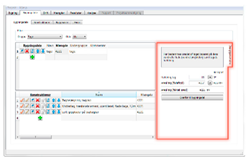 | |||||||
| Optional text | ||||||||
| Q2.10 How well does the tool meet the level of detail in your project documentation?(1 choice) | ||||||||
| Not at all | Neutral | Very well | ||||||
| Optional text | ||||||||
| Q2.11 How do you rate the available number of default components?(1 choice) | ||||||||
| Too few | Adequate | Too many | ||||||
| Optional text | ||||||||
| Q2.12 How do you rate the technical quality of the default components?(1 choice) | ||||||||
| Unacceptable | Neutral | Very high | ||||||
| Optional text | ||||||||
| Q2.13 How do you rate the output functions? | ||||||||
| a) “Quantities” tab: | Not useful | Less useful | Neutral | Useful | Very useful | |||
| b) “Results” tab: | Not useful | Less useful | Neutral | Useful | Very useful | |||
| c) “Analysis” tab: | Not useful | Less useful | Neutral | Useful | Very useful | |||
| Q2.14 Did you miss functions, which would have helped you performing the exercises today? | ||||||||
| ||||||||
| Q2.14.1 What functions? | |||||||
| Obligatory text | ||||||||
| Q2.15 Would you change your approach when performing the exercises again? | ||||||||
| ||||||||
| Q2.15.1 How? | |||||||
| Obligatory text | ||||||||
| Q2.16 What would you like to have tried or learned, if the course would continue? | ||||||||
| Optional text | ||||||||
| Q2.17 Do you have other comments regarding the tool or the course? | ||||||||
| Optional text | ||||||||
References
- The Danish Parliament. In Aftale om Klimalov; 2019; Available online: https://www.regeringen.dk/publikationer-og-aftaletekster/aftale-om-klimalov/ (accessed on 26 November 2020).
- International Energy Agency. 2019 Global Status Report for Buildings and Construction; IEA: Paris, France, 2019. [Google Scholar]
- The European Parliament and the Council. Directive 2010/31/EU; The European Parliament and the Council: Brussels, Belgium, 2010. [Google Scholar]
- The European Parliament and the Council. Directive 2012/27/EU; The European Parliament and the Council: Brussels, Belgium, 2012. [Google Scholar]
- Blengini, G.A.; di Carlo, T. The changing role of life cycle phases, subsystems and materials in the LCA of low energy buildings. Energy Build. 2010, 42, 869–880. [Google Scholar] [CrossRef]
- Chastas, P.; Theodosiou, T.; Kontoleon, K.J.; Bikas, D. Normalising and assessing carbon emissions in the building sector: A review on the embodied CO2 emissions of residential buildings. Build. Environ. 2018, 130, 212–226. [Google Scholar] [CrossRef]
- Röck, M.; Passer, A.; Ramon, D.; Allacker, K. The coupling of BIM and LCA—challenges identified through case study implementation. In Proceedings of the IALCCE 2018—The Sixth International Symposium on Life-Cycle Engineering—Ghent, Ghent, Belgium, 28–31 October 2018; pp. 841–846. [Google Scholar]
- Russell-Smith, S.V.; Lepech, M.D.; Fruchter, R.; Littman, A. Impact of progressive sustainable target value assessment on building design decisions. Build. Environ. 2015, 85, 52–60. [Google Scholar] [CrossRef]
- Passer, A.; Ouellet-Plamondon, C.; John, V.; Kenneally, P.; Habert, G. The impact of future scenarios on building refurbishment strategies towards plus energy buildings. Energy Build 2016, 124, 153–163. [Google Scholar] [CrossRef]
- Frischknech, R.; Balouktsi, M.; Lützkendorf, T.; Aumann, A.; Birgisdottir, H.; Ruse, E.G.; Hollberg, A.; Kuittinen, M.; Lavagna, M.; Lupišek, A.; et al. Environmental benchmarks for buildings: Needs, challenges and solutions—71st LCA forum. Int. J. Life Cycle Assess 2019, 24, 2272–2280. [Google Scholar]
- Lützkendorf, T. Assessing the environmental performance of buildings: Trends, lessons and tensions. Build. Res. Inf. 2018, 46, 594–614. [Google Scholar]
- Stichting Bouwkvaliteit. Determination Method—Environmental Performance Buildings and Civil Engineering Works 3.0; 2019; Available online: https://milieudatabase.nl/downloads/05-determination-method-v3-0-jan2019-en/ (accessed on 26 November 2020).
- Finish Ministry of the Environment. Method for the Whole Life Carbon Assessment of Buildings—2019:13; 2019; Available online: https://www.google.com/url?sa=t&rct=j&q=&esrc=s&source=web&cd=&ved=2ahUKEwiRjPi6lsPuAhVJAhAIHZiKA34QFjAAegQIARAC&url=https%3A%2F%2Fjulkaisut.valtioneuvosto.fi%2Fbitstream%2Fhandle%2F10024%2F161796%2FYM_2019_23_Method_for_the_whole_life_carbon_assessment_of_buildings.pdf%3Fsequence%3D1%26isAllowed%3Dy&usg=AOvVaw2tL_b_CEMJLzTLnpvHJ276 (accessed on 26 November 2020).
- Finansdepartementet. Klimadeklaration för Byggnader. Ds 2020:4; 2020; Available online: https://www.regeringen.se/4a4044/contentassets/3e13a513131b447f8b1e41eddcbbf6b5/klimatdeklaration-for-byggnader-ds-20204.pdf (accessed on 26 November 2020).
- Norsk Standard. Method for Greenhouse Gas Calculations for Buildings— NS 37:2018; Standard Norge: Oslo, Norway, 2018. [Google Scholar]
- Vejledning om den Frivillige Bæredygtighedsklasse; The Danish Transport Construction and Housing Authority: København, Danish, 2020; p. 91.
- Weißenberger, M.; Jensch, W.; Lang, W. The convergence of life cycle assessment and nearly zero-energy buildings: The case of Germany. Energy Build. 2014, 76, 551–557. [Google Scholar] [CrossRef]
- Marsh, R.; Rasmussen, F.N.; Birgisdottir, H. Embodied Carbon Tools for Architects and Clients Early in the Design Process; Pomponi, C.D.W.F., Moncaster, A., Eds.; Springer: Berlin/Heidelberg, Germany, 2018. [Google Scholar]
- Basbagill, J.; Flager, F.; Lepech, M.; Fischer, M. Application of life-cycle assessment to early stage building design for reduced embodied environmental impacts. Build. Environ. 2013, 60, 81–92. [Google Scholar] [CrossRef]
- John, V. Derivation of Reliable Simplification Strategies for the Comparative LCA of Individual and Newly Built Swiss Apartment Buildings. Ph.D. Thesis, Swiss Federal Institute of Technology in Zurich, Zürich, Switzerland, 2013. [Google Scholar]
- Lamé, G.; Leroy, Y.; Yannou, B. Ecodesign tools in the construction sector: Analyzing usage inadequacies with designers’ needs. J. Clean. Prod. 2017, 148, 60–72. [Google Scholar] [CrossRef]
- Meex, E.; Hollberg, A.; Knapen, E.; Hildebrand, L.; Verbeeck, G. Requirements for applying LCA-based environmental impact assessment tools in the early stages of building design. Build. Environ. 2018, 133, 228–236. [Google Scholar] [CrossRef]
- Olinzock, M.A.; Landis, A.E.; Saunders, C.L.; Collinge, W.O.; Jones, A.K.; Schaefer, L.A.; Bilec, M.M. Life cycle assessment use in the North American building community: Summary of findings from a 2011/2012 survey. Int. J. Life Cycle Assess. 2015, 20, 318–331. [Google Scholar] [CrossRef]
- Saunders, C.L.; Landis, A.E.; Mecca, L.P.; Jones, A.K.; Schaefer, L.A.; Bilec, M.M. Analyzing the Practice of Life Cycle Assessment. J. Ind. Ecol. 2013, 17, 777–788. [Google Scholar] [CrossRef]
- European Committee for Standardization CEN/TC350. EN 15978:2012; CEN: Brussels, Belgium, 2012. [Google Scholar]
- Schlanbusch, R.D.; Fufa, S.M.; Häkkinen, T.; Vares, S.; Birgisdottir, H.; Ylmén, P. Experiences with LCA in the Nordic Building Industry—Challenges, Needs and Solutions. Energy Procedia 2016, 96, 82–93. [Google Scholar] [CrossRef]
- De Wolf, C.; Pomponi, F.; Moncaster, A. Measuring embodied carbon dioxide equivalent of buildings: A review and critique of current industry practice. Energy Build. 2017, 140, 68–80. [Google Scholar] [CrossRef]
- Stichting Bouwkvaliteit. Bepalingsmethode Milieuprestatie Gebouwen en GWW-werken Versie 3.0; Stichting Bouwkvaliteit: Rijswijk, The Netherlands, 2019; p. 82. [Google Scholar]
- Danish Transport, Construction and Housing Authority. Den Frivillige Bæredygtighedsklasse. 2020. Available online: https://baeredygtighedsklasse.dk/ (accessed on 2 June 2020).
- Kuittinen, M.; Häkkinen, T. Reduced carbon footprints of buildings: New Finnish standards and assessments. Build. Cities 2020, 1, 182–197. [Google Scholar] [CrossRef]
- Athena Impact Estimator for Buildings. Available online: https://calculatelca.com/software/impact-estimator/ (accessed on 26 November 2020).
- Baubook Eco2soft. Available online: https://www.baubook.info/eco2soft/ (accessed on 26 November 2020).
- CAALA GmbH. Available online: https://caala.de/ (accessed on 26 November 2020).
- Federal Institute for Research on Building, Urban Affairs and Spatial Development. Available online: https://www.bauteileditor.de (accessed on 26 November 2020).
- Bionova Ltd. Available online: https://www.oneclicklca.com/ (accessed on 26 November 2020).
- Anavitor. Available online: http://www.anavitor.se/Anavitor (accessed on 26 November 2020).
- BM-Byggsektorns Miljöberäkningsverktyg. Available online: https://www.ivl.se/projektwebbar/byggsektorns-miljoberakningsverktyg.html (accessed on 26 November 2020).
- Danish Government. Vejen til et Styrket Byggeri i Danmark—Regeringens Byggepolitiske Strategi; Danish Government: Copenhagen, Danish, 2014. [Google Scholar]
- Birgisdottir, H.; Sørensen, C.G.; Rasmussen, F.N.; Skovgaard, M.; Aggerholm, S. LCAbyg Version1; Aalborg University: Copenhagen, Denmark, 2015. [Google Scholar]
- Birgisdottir, H.; Rasmussen, F.N. Development of LCAbyg: A National Life Cycle Assessment Tool for Buildings in Denmark. In Proceedings of the IOP Conference Series: Earth and Environmental Science, Saint Petersburg, Russian, 17–18 April 2019; Volume 290. [Google Scholar]
- Rasmussen, F.N.; Birgisdottir, H. Development of the LCAbyg tool: Influence of user requirements and context. In Proceedings of the Sustainable Built Environment Conference 2016 in Hamburg: Strategies, Stakeholders, Success factors, Hamburg, Germany, 7–11 March 2016; pp. 380–389. [Google Scholar]
- Kanafani, K.; Birgisdottir, H.; Zimmermann, R.K.; Sørensen, C.G. LCAbyg 4; Aalborg University: Copenhagen, Denmark, 2019. [Google Scholar]
- Birgisdóttir, H.; Hansen, K.; Haugbølle, K.; Hesdorf, P.; Olsen, I.S.; Mortensen, S. Bæredygtigt Byggeri: Afprøvning af Certificeringsordninger til Måling af Bæredygtighed i Byggeri; Byggeriets Evaluerings Center: København K, Denmark, 2010. [Google Scholar]
- Gantner, J.; Lenz, K.; Horn, R.; von Both, P.; Ebertshäuser, S. Ökobau.dat 3.0–Quo Vadis? Buildings 2018, 8, 129. [Google Scholar] [CrossRef]
- European Committee for Standardization CEN/TC350. EN 15804:2012+A1:2013; CEN: Brussels, Belgium, 2013. [Google Scholar]
- CML-IA Characterisation Factors; University of Leiden: Leiden, The Netherlands, 2016.
- Aagaard, N.-J.; Brandt, E.; Aggerholm, S.; Haugbølle, K. Lifespan of building components when assessing sustainability and total economy. Build Ele Assess Sus Life Cycle Cost. 2013, 30, 48. [Google Scholar]
- COWI A/S. New Emission Factors for Electricity and District Heating; COWI A/S: Kongens Lyngby, Denmark, 2016. [Google Scholar]
- Energiforskning.dk. Low energy buildings and embodied energy in a sustainability perspective: New knowledge and tools for consultants and clients. 2019. Available online: https://energiforskning.dk/en/projects/detail?program=All&teknologi=All&field_bevillingsaar_value=&start=&slut=&field_status_value=All&keyword=lowenergybuildingsandembodiedenergy&page=0 (accessed on 22 January 2020).
- Kanafani, K.; Zimmermann, R.K.; Rasmussen, F.N.; Birgisdóttir, H. Early Design Stage Building LCA using The LCAbyg Tool: New Strategies For Bridging The Data Gap. IOP Conf. Ser. Earth Environ. Sci. 2019, 323, 12117. [Google Scholar] [CrossRef]
- Zimmermann, R.K.; Kanafani, K.; Rasmussen, F.N.; Birgisdóttir, H. Early Design Stage Building LCA using the LCAbyg tool: Comparing Cases for Early Stage and Detailed LCA Approaches. IOP Conf. Ser. Earth Environ. Sci. 2019, 323, 12118. [Google Scholar] [CrossRef]
- Kanafani, K.; Zimmermann, R.K.; Birgisdóttir, H.; Rasmussen, F.N. LCA in Early Building Design: Introduction to the Method and Environmental Profile Examples (in Danish); Aalborg University: Copenhagen, Denmark, 2019. [Google Scholar]
- Rambøll Management Consulting. SurveyXact. Available online: https://www.surveyxact.dk/ (accessed on 22 January 2020).
- Baubook GmbH. Baubook; Available online: https://www.firmenabc.at/baubook-gmbh_Dzge (accessed on 26 November 2020).
- Attia, S.; Hensen, J.L.M.; Beltrán, L.; de Herde, A. Selection criteria for building performance simulation tools: Contrasting architects’ and engineers’ needs. J. Build. Perform. Simul. 2012, 5, 155–169. [Google Scholar] [CrossRef]
- Sørensen, N.L.; Gottlieb, S.C. SBi 2018:08—Byggebranchens Anvendelse af IKT; Aalborg University: Copenhagen, Denmark, 2018. [Google Scholar]
- Cavalliere, C.; Habert, G.; Dell’Osso, G.R.; Hollberg, A. Continuous BIM-based assessment of embodied environmental impacts throughout the design process. J. Clean. Prod. 2019, 211, 941–952. [Google Scholar] [CrossRef]
- Hollberg, A.; Genova, G.; Habert, G. Evaluation of BIM-based LCA results for building design. Autom. Constr. 2020, 109, 102972. [Google Scholar] [CrossRef]
- Soust-Verdaguer, B.; Llatas, C.; García-Martínez, A. Critical review of bim-based LCA method to buildings. Energy Build. 2017, 136, 110–120. [Google Scholar] [CrossRef]
- Tsikos, M.; Negendahl, K. Sustainable Design with Respect to LCA Using Parametric Design and BIM Tools. In Proceedings of the World Sustainable Built Environment Conference 2017, Hong Kong, China, 5–7 June 2017. [Google Scholar]
- Resch, E.; Lausselet, C.; Brattebø, H.; Andresen, I. An analytical method for evaluating and visualizing embodied carbon emissions of buildings. Build. Environ. 2020, 168, 106476. [Google Scholar] [CrossRef]
- Miyamoto, A.; Allacker, K.; de Troyer, F. Visual tool to integrate LCA and LCC in the early design stage of housing. IOP Conf. Ser. Earth Environ. Sci. 2019, 323, 12161. [Google Scholar] [CrossRef]
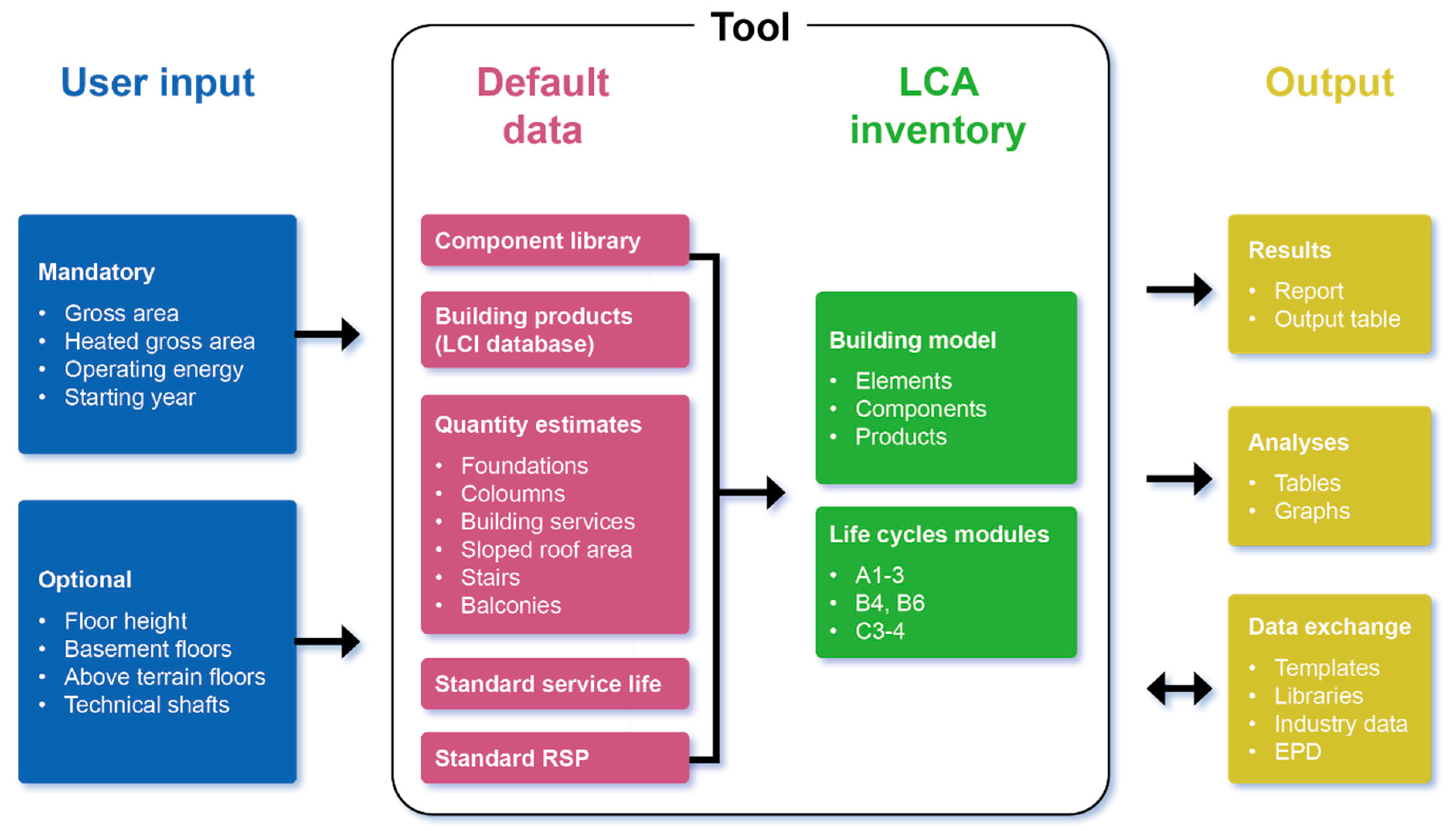
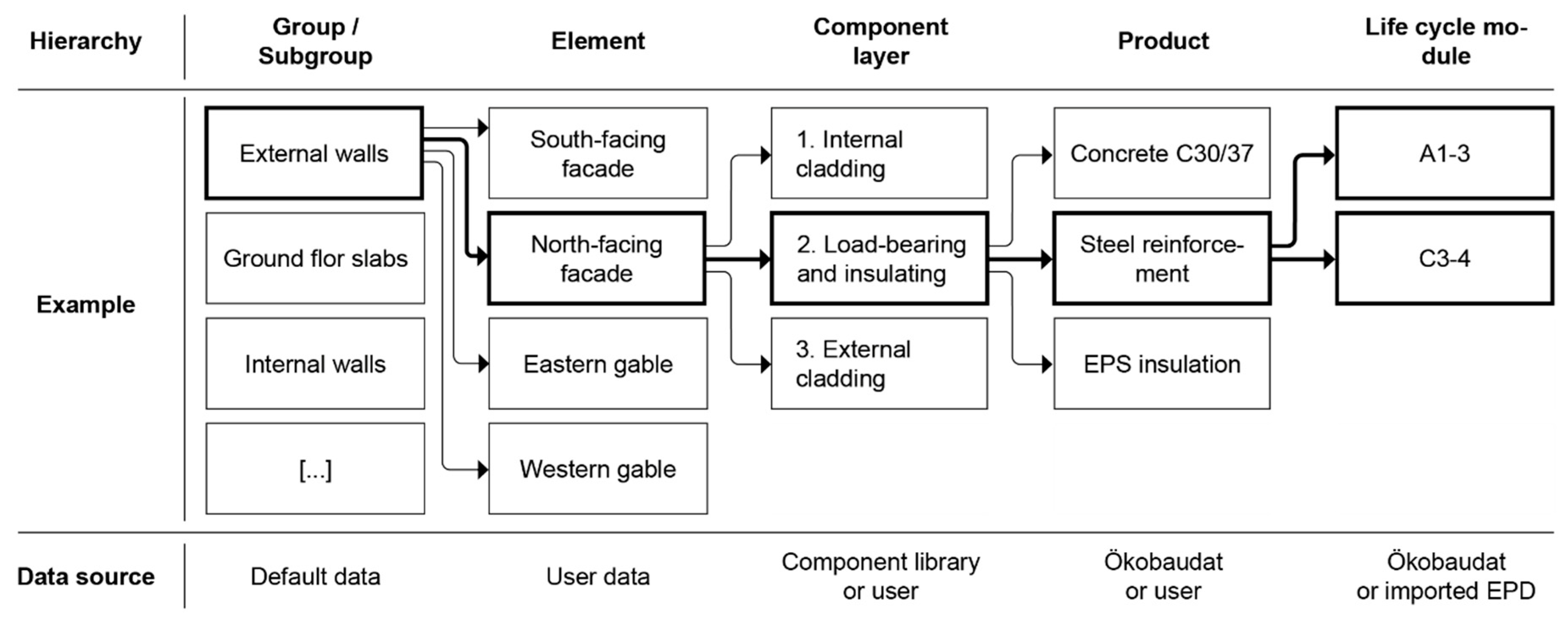
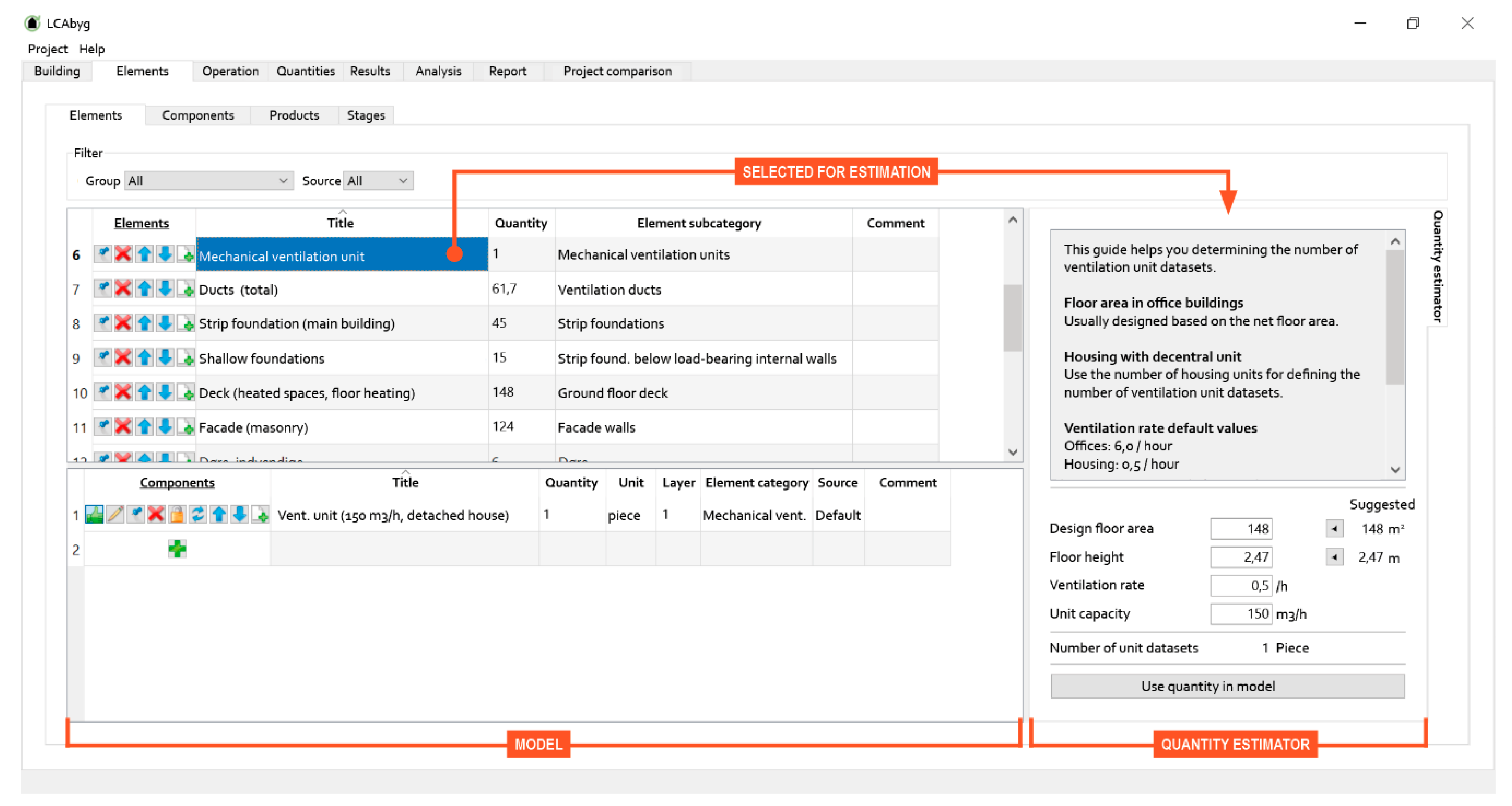
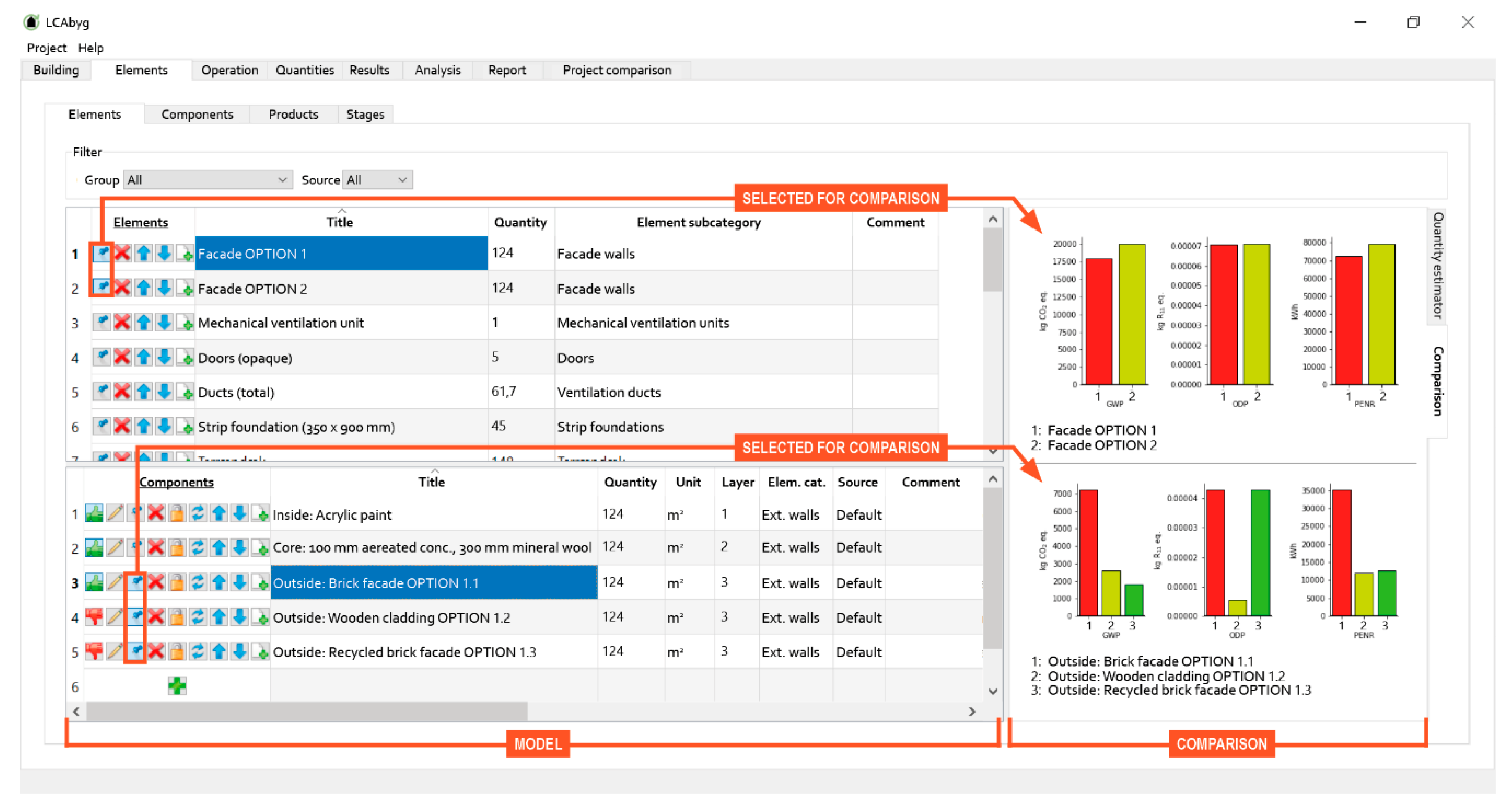
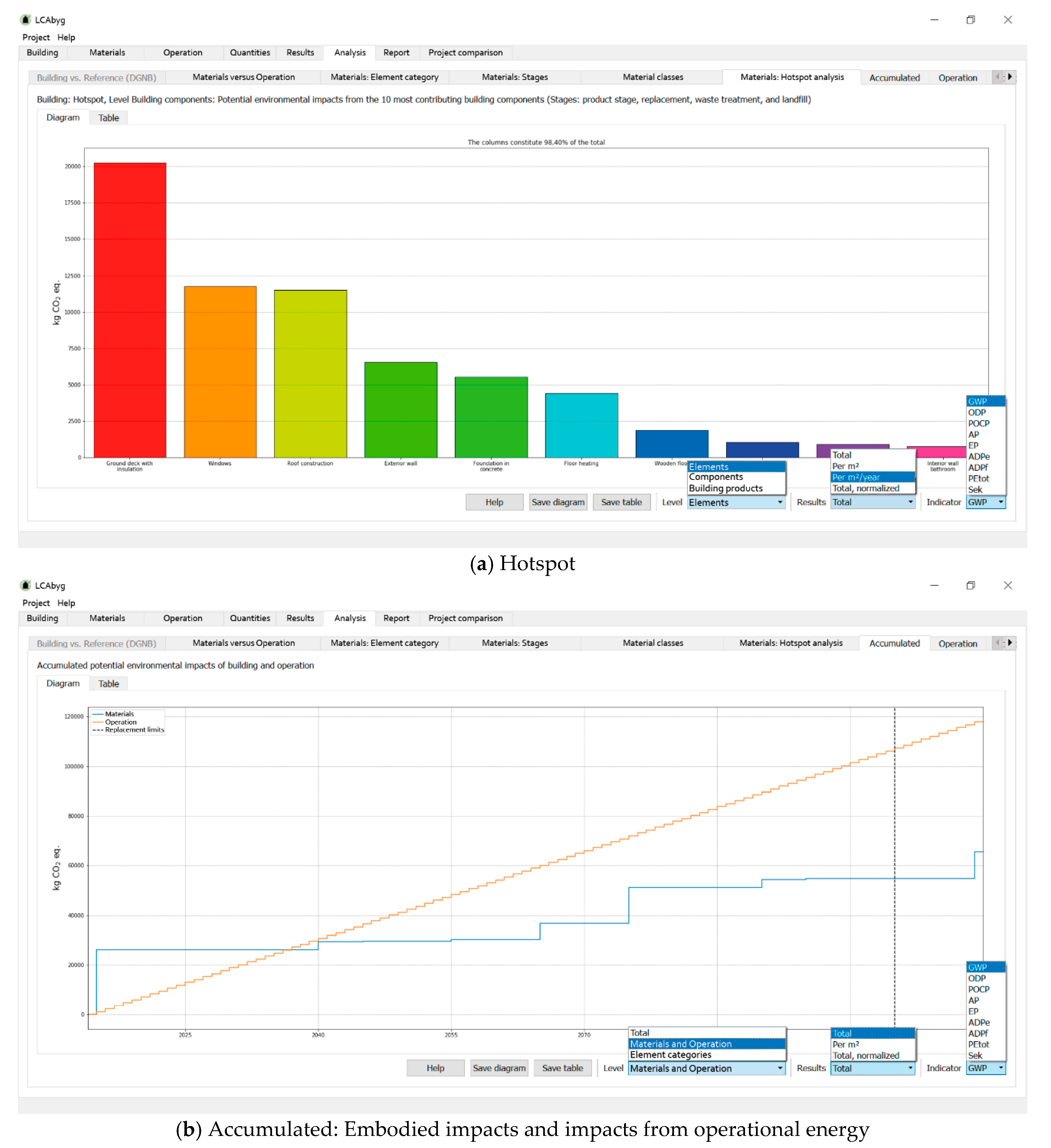
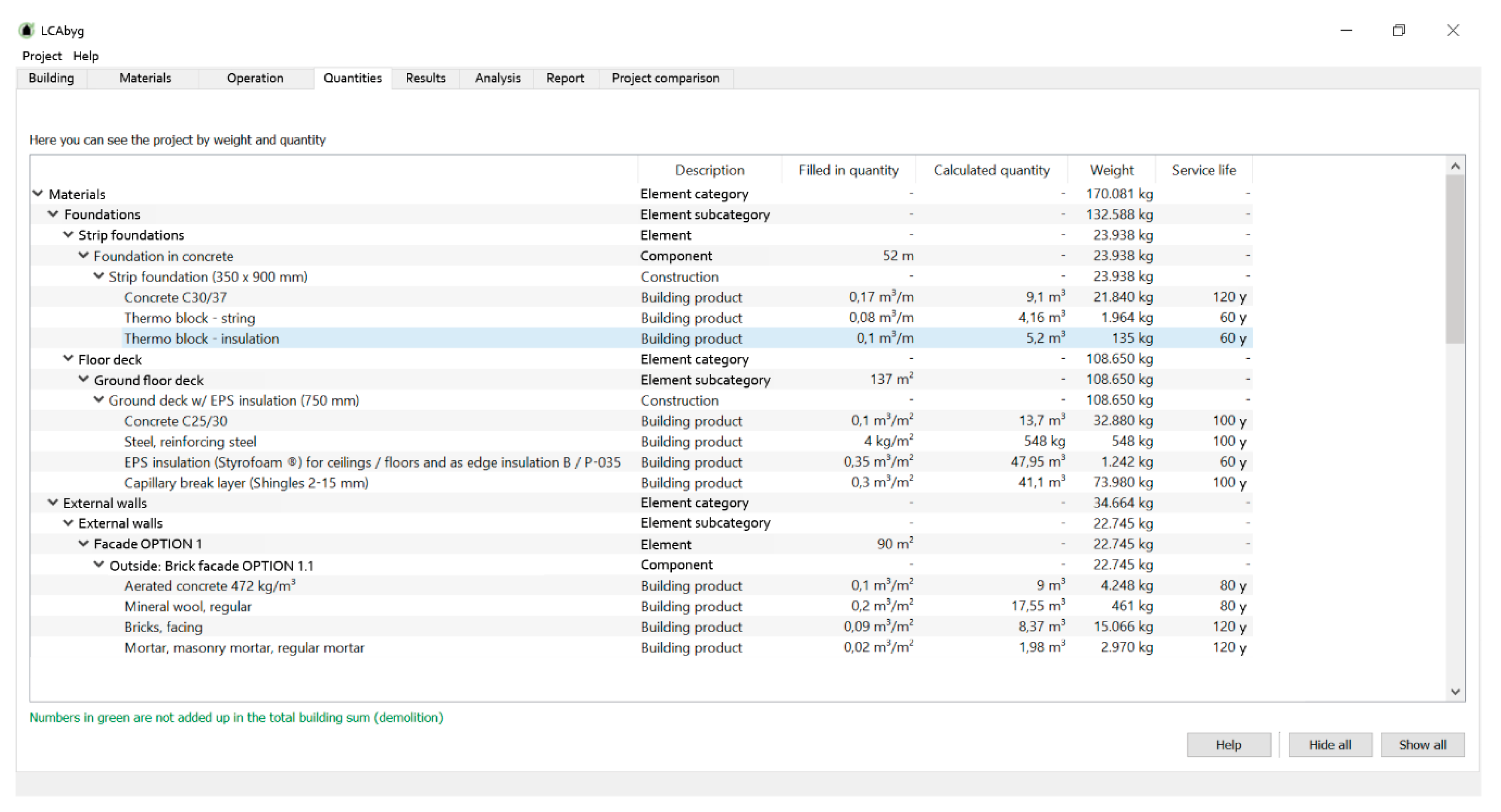
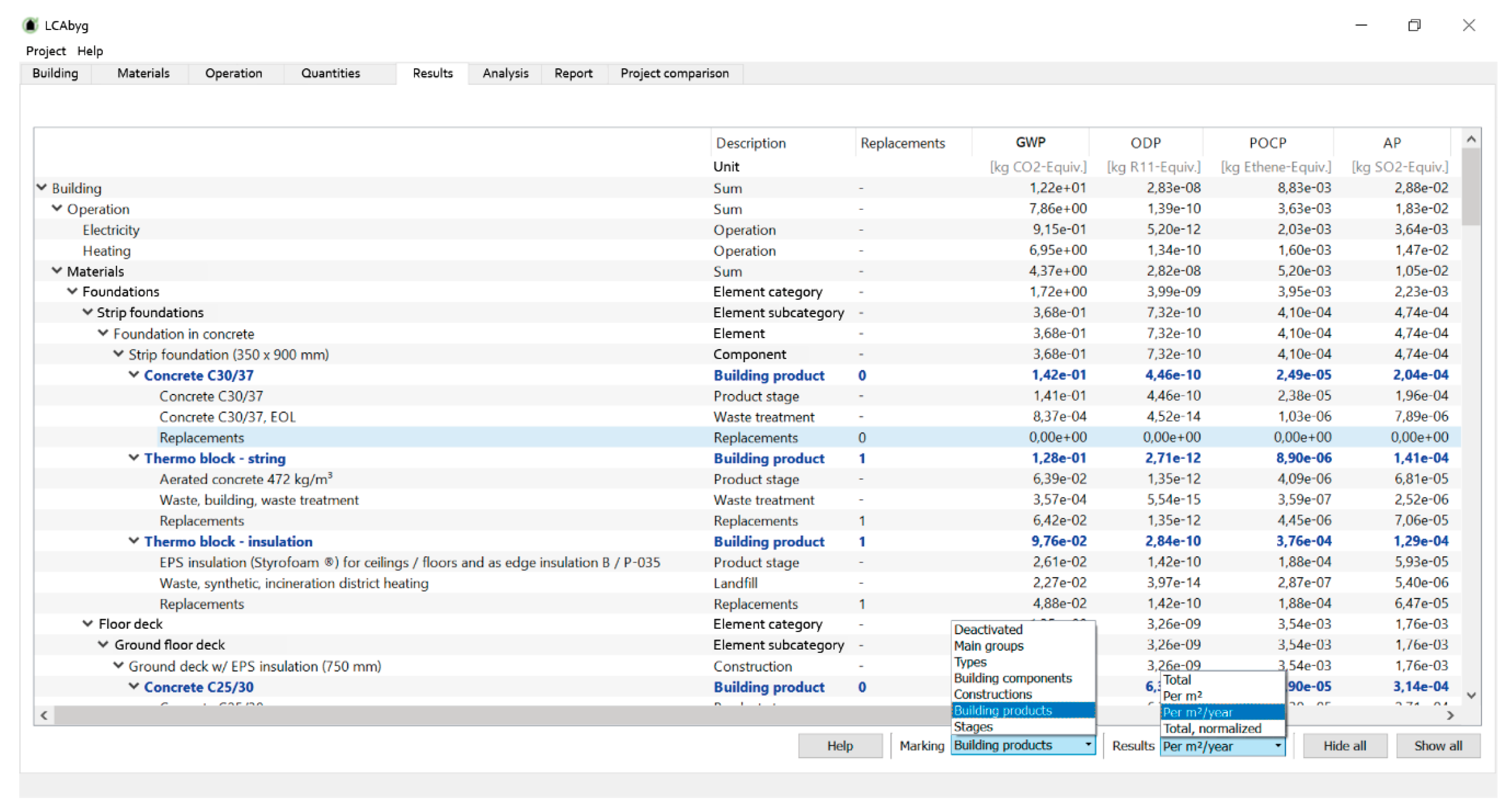
| No. | Activity | Topic | Participant (Main Profile) | Participant (No.) |
|---|---|---|---|---|
| 1 | Workshop 1 | Preconditions for early design LCA | Architects, civil engineers, drafters | 18 |
| 2 | Workshop 2 | tool requirements | Civil engineers | 7 |
| 3 | Workshop 3 | Component library development | Delegates from consultancies, contractors, manufacturers | 12 |
| 4 | Industry consultation | |||
| 5 | Industry hearing | Component library evaluation | Delegates from consultancies, contractors, manufacturers | 30 |
| 6 | Workshop 4 | |||
| 7 | Course 1–5 | Training/tool test | Architects, civil engineers, drafters | 99 |
| 8 | Course 6–7 | Training/tool test | Drafter students | 72 |
| 9 | Workshop 5 | Design guide publication [52], discussion of first draft | Architects, civil engineers, drafters | 21 |
| User Requirement | Tool Feature |
|---|---|
| Available default data and settings |
|
| Versatility |
|
| Environmental feedback for informing design |
|
| Transparent results |
|
| Element Group | Comp. Layer 1 | Comp. Layer 2 | Comp. Layer 3 |
|---|---|---|---|
| Foundations | Foundations | - | - |
| Ground floor slabs | Flooring | Load-bearing system | Insulation and underlay |
| External walls | Inside finishing | Load-bearing and insulating system | Façade system |
| Internal walls | Finishing | Load-bearing and insulating system | Finishing |
| Floor decks | Flooring | Load-bearing and insulating system | Ceiling |
| Stairs and ramps | Structure | Flooring | Balustrades and handrails |
| Columns and beams | Columns and beams | - | - |
| Balconies | Platform | - | - |
| Roofs | Roof cladding | Load-bearing and insulating system | Ceiling |
| Windows, doors, glazing systems | Profiles | Panes | Solar shading |
| Building services | Production unit | Distribution | Terminal unit |
Publisher’s Note: MDPI stays neutral with regard to jurisdictional claims in published maps and institutional affiliations. |
© 2021 by the authors. Licensee MDPI, Basel, Switzerland. This article is an open access article distributed under the terms and conditions of the Creative Commons Attribution (CC BY) license (http://creativecommons.org/licenses/by/4.0/).
Share and Cite
Kanafani, K.; Kjær Zimmermann, R.; Nygaard Rasmussen, F.; Birgisdóttir, H. Learnings from Developing a Context-Specific LCA Tool for Buildings—The Case of LCAbyg 4. Sustainability 2021, 13, 1508. https://doi.org/10.3390/su13031508
Kanafani K, Kjær Zimmermann R, Nygaard Rasmussen F, Birgisdóttir H. Learnings from Developing a Context-Specific LCA Tool for Buildings—The Case of LCAbyg 4. Sustainability. 2021; 13(3):1508. https://doi.org/10.3390/su13031508
Chicago/Turabian StyleKanafani, Kai, Regitze Kjær Zimmermann, Freja Nygaard Rasmussen, and Harpa Birgisdóttir. 2021. "Learnings from Developing a Context-Specific LCA Tool for Buildings—The Case of LCAbyg 4" Sustainability 13, no. 3: 1508. https://doi.org/10.3390/su13031508
APA StyleKanafani, K., Kjær Zimmermann, R., Nygaard Rasmussen, F., & Birgisdóttir, H. (2021). Learnings from Developing a Context-Specific LCA Tool for Buildings—The Case of LCAbyg 4. Sustainability, 13(3), 1508. https://doi.org/10.3390/su13031508








